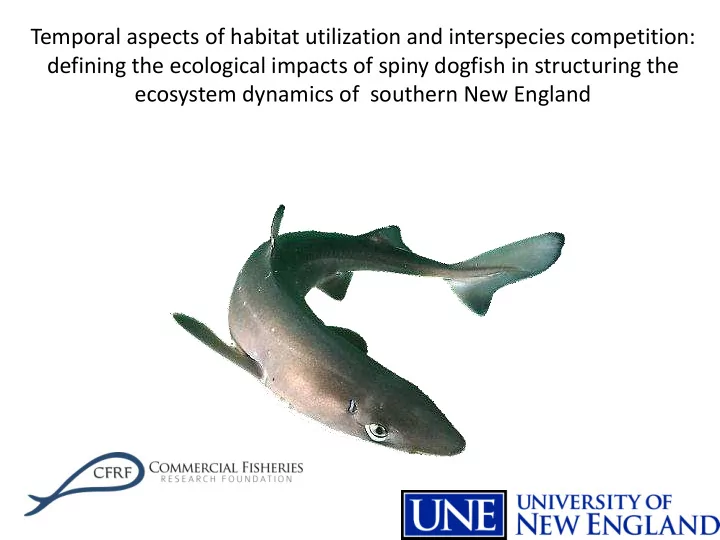

Temporal aspects of habitat utilization and interspecies competition: defining the ecological impacts of spiny dogfish in structuring the ecosystem dynamics of southern New England
"Voracious almost beyond belief, the dogfish entirely deserves its bad reputation” .
Jim Armstrong MAFMC
Movement Reproduction Ecology Essential Habitat
Vertical Movement (Depth)
Diel Movement PM AM PM
� Directed Collaborative and Cooperative Research Opportunity – Subject area: Spiny Dogfish, Squalus acanthias Hypothesis 1: Based on satellite tag data and anecdotal evidence from fisherman, we aimed to test whether an active vertical movement pattern exhibited by spiny dogfish prevents this species from being effectively captured by NEFSC otter trawl surveys. Hypothesis 2: Dogfish do not migrate south, out of southern New England waters, during the winter.
Hypothesis 1 and 2 : Monthly bottom and mid water surveys occured in tandem (side by side). This will allow for temporal and spatial comparisons to be made between the abundance of spiny dogfish captured on the benthos to those captured in mid water.
Dogfish Food Habits, SPRING SURVEY A starting point for ecosystem implications Other Inverts 23.5% S quids 5.2% Comb Jellies 13.8% Herring 10.9% Other Fish 20.7% Mackerel Flatfish 19.1% 2.5% Cod-Like Fish 4.3% Based on 40,000 stomachs examined (fall + spring) Courtesy of Paul Rago, NMFS
Hypothesis 3 : If hypotheses 1 and 2 were true, then a year round dogfish population would impact ecosystem dynamics within this region. Conducting stable isotope and stomach content analysis order to test for direct and indirect competition and the impacts of these interactions on other commercially important species.
F ( + ) N W IRI = Stomach Content Index of Relative Importance
Stable Isotope Analysis Carnivores Long-term Omnivores Liver and muscle δ 13 C and δ 15 N Herbivores Primary Producers δ 15 N = 12.5 o/oo δ 15 N = 16.1 o/oo δ 15 N = 8.6 o/oo δ 15 N = 10.5 o/oo
Hypothesis 1: Based on satellite tag data and anecdotal evidence from fisherman, we aimed to test whether an active vertical movement pattern exhibited by spiny dogfish prevents this species from being effectively captured by NEFSC otter trawl surveys. Hypothesis 2: Dogfish do not migrate south, out of southern New England waters, during the winter. Hypothesis 3 : If hypotheses 1 and 2 were true, then a year round dogfish population would impact ecosystem dynamics within this region. Temporal aspects of habitat utilization and interspecies competition: defining the ecological impacts of spiny dogfish in structuring the ecosystem dynamics of southern New England
December 2010 March 2011 April 2011 May 2011 July 2011 August 2011 November 2011 September 2011 February 2012 5, 30 min tows
Hypothesis 1: Based on satellite tag data and anecdotal evidence from fisherman, we aimed to test whether an active vertical movement pattern exhibited by spiny dogfish prevents this species from being effectively captured by NEFSC otter trawl surveys
1400 1200 1000 Number of Individuals 800 Bottom Midwater 600 400 200 0 Dec-10 Mar-11 Apr-11 May-11 Jul-11 Aug-11 Nov-11 Month
Improvements? • Learning process for everyone • 7 months sampled • Only conducted during the daylight hours
23,000,000 Jim Armstrong MAFMC
Hypothesis 2: Dogfish do not migrate south, out of southern New England waters, during the winter
1400 1361 1200 1124 1000 Number of Individuals 800 603 600 556 528 506 442 400 200 129 108 17 8 8 1 0 1 1 0 Dec-10 Feb-11 Mar-11 Apr-11 May-11 Jul-11 Aug-11 Nov-11 Month
Kernel Utilization Distribution (KUD)
16 Months Full Term R 2 = 0.94 P < 0.001 6-8 months shorter than the literature suggests
Jim Armstrong MAFMC
Hypothesis 3 : If hypotheses 1 and 2 are true, then a year round dogfish population would impact ecosystem dynamics within this region Link and Garrison Dominant Piscivore outcompetes other species
Dogfish %IRI n = 208 Longfin Squid Jellyfish Bones Shortfin Squid Green Crab Sea Robin Clam Baby Dogfish Anaskid Worm Amphipod 45% 20% Blueback Herring Unknown Bird Mackerel Squid Whiting Summer Flounder American Eel 24% Crab Skate Gadiforme Cod Intestines Butterfish Teleost Rock Crab
Dogfish %IRI n = 208 Atlantic Cod %IRI n = 19 5% 3% 6% 20% 45% 62% 23% 24% Herring Striped Bass %IRI n = 27 Bluefish %IRI n = 16 Unidentified Fish 4% Rock Crab 12% 17% Butterfish 43% 49% 37% Squid 30% Monkfish %IRI n = 1 Amphipod Flounder 10% 90%
Black Sea Bass %IRI n = 7 Smooth Dogfish %IRI n = 17 6% 5% 10% 77% 92% Scup %IRI n = 16 Whiting %IRI n = 6 Rock Crab 6% Unidentified Fish Shrimp 36% 62% Shortfin Squid 94% Amphipod Fluke %IRI n = 16 9% 85%
δ N 15 Species Sample Size δC 13 (‰) δN 15 (‰) Cod 17 -18.1 (0.3) 14.5 (0.3) Dogfish 14 -18.3 (0.6) 14.8 (0.4) δ C 13
Where are we now • Developing an ecopath model Data already entered into model : habitat area, biomass in the habitat area, production/biomass, consumption/biomass values, landings, discards and catch rates Still being entered – diet composition • 300 SIA samples are being analyzed • Depth, fishing location and/or water temperature significantly affects catches of spiny dogfish
Questions..
Recommend
More recommend